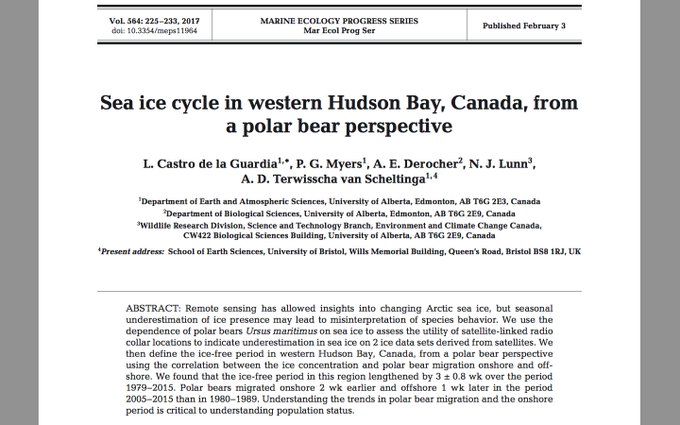From our research: period W. Hudson Bay #polarbears are onshore increased from ca. 107 to 130 d from 1979 to 2015. Not good for the bears.
New Study: ‘No Change’ for West Hudson Bay Polar Bears
A newly-published paper shows that there has been no trend in the time Western Hudson Bay polar bears spent onshore between 2001-2015 due to sea ice conditions at breakup or freeze-up (previously available to 2010 only), despite the marked decline of global sea ice since 2007.
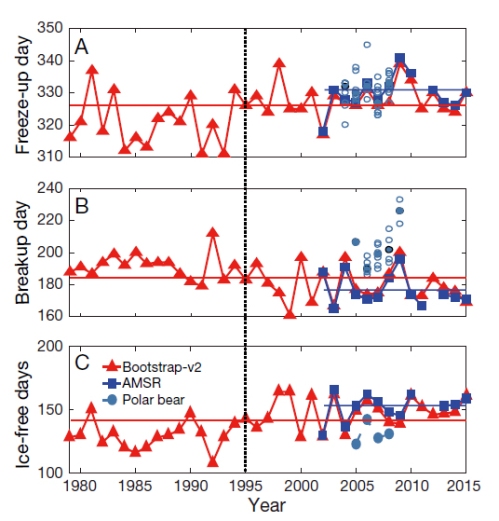
Figure 3 from Castro de la Guardia (2017) showing freeze-up and breakup dates and ice-free days 1979-2015 for Western Hudson Bay. Figure with caption is copied below, with explanation of symbols.
Previously, a 2007 paper by Eric Regehr and colleagues for WHB bears up to 2004, which was used to support the US bid to list polar bears as ‘threatened’ with extinction, concluded that between 1984 and 2003, bears were spending 3 weeks long onshore than they did in the 1980s.
The big news from Castro de la Guardia (2017) is that polar bears spent longer onshore from 1979-2015 by … 3 weeks. That is, no change from the situation in 2004. Wow!
Note the population size of the entire WHB subpopulation has also not declined since 2004 and is currently estimated at about 1030, based on a 2011 aerial survey (Stapleton et al. 2014).
Thanks to Andrew Derocher for the heads-up tweet.
From the abstract (my bold):
We found that the ice-free period in this region lengthened by 3 ± 0.8 wk over the period 1979−2015. Polar bears migrated onshore 2 wk earlier and offshore 1 wk later in the period 2005−2015 than in 1980−1989.
Here is the region in question, illustrated by Fig. 1 from the paper:
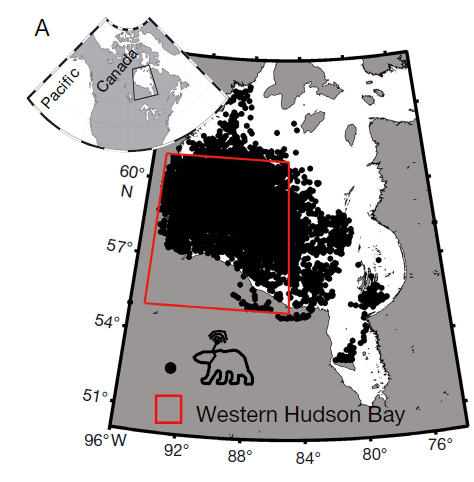 The significant information contained in this paper is breakup and freeze-up dates and length of the ice-free period data for 2010-2015, which has been unavailable until now. More excerpts and comments below, including Figure 3 with its caption.
The significant information contained in this paper is breakup and freeze-up dates and length of the ice-free period data for 2010-2015, which has been unavailable until now. More excerpts and comments below, including Figure 3 with its caption.
Here is the updated ‘official’ breakup and freeze-up data, which has been unavailable since 2010 (Lunn et al. 2016 and earlier versions) – see Fig 3 below, from the paper, all showing the lack of any trend for 2001-2015.
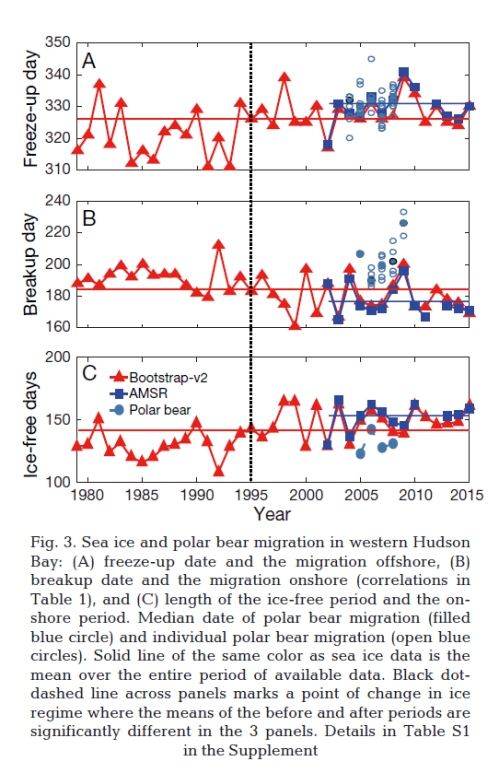
While it is certainly true that the overall trend in time onshore since 1979 has been decline, the lack of a continued trend since 2001 is not what was expected or predicted, especially given the marked decline in global sea ice levels that occurred from 2007-2015 (Crockford 2017), and the predictions of how devastating such low levels of ice would be to polar bears in areas like Hudson Bay that have only seasonal sea ice.
From Castro de la Guardia (2017), page 230-2311:
The time series of freeze-up date from 1979 to 2015 using Bootstrap-v2 shows a positive trend (p = 0.01) of 0.29 d yr−1, with a marked shift in the 1990s (Fig. 3A). From 1979 to 1989, the mean freeze-up date (±SD) was 16 November (± 5 d), while in 2005−2015 it was delayed by 8 d to 24 November (±8 d) (t-test, p = 0.01).
…
From 1979 to 1989, mean breakup date was 11 ± 4 July, while in 2005−2015 it advanced 14 d to 28 ± 9 June (t-test, p <0.01). During the most recent decades there was also higher inter-annual variability in the breakup date.
The inter-annual variability increased from 5 ± 4 d between 1979 and 1989 to 19 ± 11 d between 1996 and 2015 (t-test, p < 0.01). The later decades included a short period (2005−2009) with a trend towards a later breakup, to which polar bears responded by arriving onshore later (Fig. 3B). [my bold]
From Regehr et al. (2007), page 2677:
Using linear regression, the mean sea ice breakup date in 2003 (21 Jun)
occurred 19.5 days earlier than in 1984 (12 Jul). The trend toward earlier
breakup during the current study was consistent with the entire available time series (linear regression from 1971 to 2004). From 1984 to 2003, there was not a statistically significant change in the date of freeze-up in western Hudson Bay.
Regehr et al. (2007: 2680), regarding the post-2004 future [my bold]:
Polar bears in western Hudson Bay are likely to be among the first to show population-level effects of climatic warming because they occur near the southern limit of the species’ range and because recent temperature increases in the region have been among the largest in the Arctic.
See also Stirling and Parkinson (2006) for a similar statement.
No explicit prediction of either sea ice levels or polar bear declines expected after 2004 in the scientific literature circa 2006/2007 but in a February 2013 Wall Street Journal essay, author Zac Unger remarked, based on interviews with a number of polar bear researchers (see further discussion of Unger’s writing here):
…in Churchill, where tourists crowd into rumbling “Tundra Buggies” to watch polar bears cavort, the population fell from 1,194 to 935 between 1984 and 2004. After that 2004 count, scientists predicted that the population would crater to 676 bears by 2011. But a recent survey found more than 1,000 bears there… [my bold]
CONCLUSION (MINE)
Western Hudson Bay breakup and freeze-up dates haven’t shown appreciable change since 2001 as predicted (although they are more variable than in the 1980s, according to this new paper by Castro de la Guardia), and the population size has not declined as predicted either, despite the decline in average monthly Arctic sea ice extent (global) for September since 2007 (see NSIDC graph below).
Odd, that – which I’ve noted before.
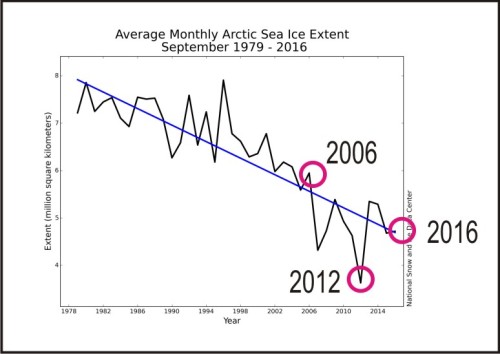
FOOTNOTE:
- Only four years of new polar bear data related to breakup and freeze-up were used in this analysis, from fall 2004-spring 2009 (see Supplement), overlapping similar data collected and report by Cherry et al. (2013), discussed previously here, here, and here. In fact, it is not clear to me whether the polar bear data collected for this paper are the same or different from that reported in Cherry et al. (2013): the numbers of bears fitted with collars reported in both papers suggest the data could be the same or have a substantial overlap. Both are papers by graduate students of Andrew Derocher.
REFERENCES
Castro de la Guardia, L., Myers, P.G., Derocher, A.E., Lunn, N.J., Terwisscha van Scheltinga, A.D. 2017. Sea ice cycle in western Hudson Bay, Canada, from a polar bear perspective. Marine Ecology Progress Series 564: 225–233. http://www.int-res.com/abstracts/meps/v564/p225-233/
Cherry, S.G., Derocher, A.E., Thiemann, G.W., Lunn, N.J. 2013. Migration phenology and seasonal fidelity of an Arctic marine predator in relation to sea ice dynamics. Journal of Animal Ecology 82:912-921. http://onlinelibrary.wiley.com/doi/10.1111/1365-2656.12050/abstract
Crockford, S.J. 2017. Testing the hypothesis that routine sea ice coverage of 3-5 mkm2 results in a greater than 30% decline in population size of polar bears (Ursus maritimus). PeerJ Preprints 19 January 2017. Doi: 10.7287/peerj.preprints.2737v1 Open access. https://peerj.com/preprints/2737/
Lunn, N.J., Servanty, S., Regehr, E.V., Converse, S.J., Richardson, E. and Stirling, I. 2016. Demography of an apex predator at the edge of its range – impacts of changing sea ice on polar bears in Hudson Bay. Ecological Applications, in press. DOI: 10.1890/15-1256
Regehr, E.V., Lunn, N.J., Amstrup, S.C., and Stirling, I. 2007. Effects of earlier sea ice breakup on survival and population size of polar bears in Western Hudson Bay. Journal of Wildlife Management71: 2673-2683. http://onlinelibrary.wiley.com/doi/10.2193/2006-180/abstract
Stapleton S., Atkinson, S., Hedman, D., and Garshelis, D. 2014. Revisiting Western Hudson Bay: using aerial surveys to update polar bear abundance in a sentinel population. Biological Conservation170:38-47. http://www.sciencedirect.com/science/article/pii/S0006320713004618#
Stirling, I. and Parkinson, C.L. 2006. Possible effects of climate warming on selected populations of polar bears (Ursus maritimus) in the Canadian Arctic. Arctic 59:261-275. http://arctic.synergiesprairies.ca/arctic/index.php/arctic/issue/view/16.
Read more at polarbearscience.com
Trackback from your site.

